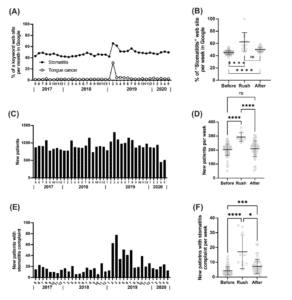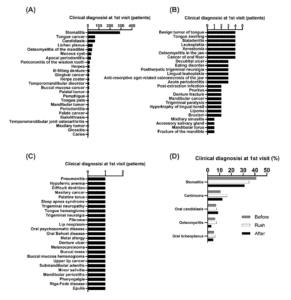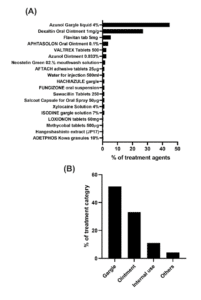Hikaru Fukuda1, Masaki Morishita2,3*, Kosuke Muraoka3, Izumi Yoshioka4, Shuji Awano3, Kentaro Ono5
1Division of Maxillofacial Surgery, Department of Science of Physical Functions, Kyushu Dental University, 2-6-1 Manazuru, Kokura-Kita, Kitakyushu, Fukuoka 803-8580, Japan
2Health Information Management Office, Kyushu Dental University Hospital, 2-6-1 Manazuru, Kokura-Kita, Kitakyushu, Fukuoka 803-8580, Japan
3Division of Clinical Education Development and Research, Department of Oral Function, Kyushu Dental University, 2-6-1 Manazuru, Kokura-Kita, Kitakyushu, Fukuoka 803-8580, Japan
4Division of Oral Medicine, Department of Science of Physical Functions, Kyushu Dental University, 2-6-1 Manazuru, Kokura-Kita, Kitakyushu, Fukuoka 803-8580, Japan
5Division of Physiology, Department of Health Promotion, Kyushu Dental University, 2-6-1 Manazuru, Kokura-Kita, Kitakyushu, Fukuoka 803-8580, Japan
*Correspondence author: Masaki Morishita DDS, PhD, Health Information Management Office, Kyushu Dental University Hospital, 2-6-1 Manazuru, Kokura-Kita, Kitakyushu, Fukuoka 803-8580, Japan and Division of Clinical Education Development and Research, Department of Oral Function, Kyushu Dental University, 2-6-1 Manazuru, Kokura-Kita, Kitakyushu, Fukuoka 803-8580, Japan; E-mail: [email protected]
Published Date: 06-10-2023
Copyright© 2023 by Morishita M, et al. All rights reserved. This is an open access article distributed under the terms of the Creative Commons Attribution License, which permits unrestricted use, distribution, and reproduction in any medium, provided the original author and source are credited.
Abstract
Aim/Background: Stomatitis is generally considered a mild disease; thus, patients are often satisfied with over-the-counter medications and do not visit hospitals. Following reports of tongue cancer in a famous actress with stomatitis in Japan, many patients complaining of stomatitis who did not usually visit hospitals flooded dental clinical offices/hospitals for several months. This study evaluated the differences in profile between patients who regularly visit the university hospital and those who are affected by social impact and wish to be screened for stomatitis and the effect of social impact on the number of new patients.
Materials and Methods: “Stomatitis” search rates on Japanese websites were calculated using Google Keyword Planner. Using the hospital’s electronic health record, the profiles of new patients with a main complaint of stomatitis were investigated via the data visualization tool Qlik sense®.
Results: During the 3-month rush period, in which keyword searches for “stomatitis” increased, the number of new patients with a main complaint of stomatitis increased two-fold compared with that during usual periods. The incidences of stomatitis and carcinoma were approximately 30% and 10%, respectively, for the rush and normal periods at initial diagnosis.
Conclusion: High social interest in oral disease prompted latent patients with stomatitis to visit dental clinical offices/hospitals and consequently contributed to the early detection of oral cancer.
Keywords: Carcinoma; Stomatitis; Tongue Neoplasms
Introduction
Stomatitis is a pain-causing mucosal disease and the most common lesion of the oral mucosa in the general population [1-3]. Etiological factors of frequent oral ulcerations include local trauma, genetic factors, malnutrition, viral and bacterial infections and immune or endocrine disturbances [3]. Moreover, detergents, preservatives, antiseptics and flavorings are frequently responsible for contact stomatitis [4-6]. As stomatitis etiology remains unclear, symptomatic therapy in hospitals is still the optimal treatment method [7]. However, patients typically consider stomatitis to be a mild condition. Sufficient and detailed dissemination of oral diseases plays an important role in encouraging patients to visit hospitals. Generally, many Japanese people are considered that they do not usually visit private dental clinics or university dental clinics unless they feel discomfort or have severe oral pain, because there is little awareness of oral disease in Japan. They may neglect pain or self-medicate with nonprescription drugs without seeking hospital treatment. Thus, some patients who develop oral cancers may neglect to seek treatment, causing cancer growth.
News reports of a famous Japanese actress diagnosed with tongue cancer after what she thought was a long-standing stomatitis in her tongue brought a flood of patients to dental facilities in Japan. Herein, we report the importance of high social interest in patients regarding oral diseases. To date, few articles have reported the frequency of tongue cancer diagnoses in patients with a main complaint of stomatitis. We compared the frequency of tongue cancer diagnoses in patients with a main complaint of stomatitis before and after February 18, 2019 in the hospital. This study aims to show the influence of high social interest regarding oral diseases on the number of patients seeking screening for said diseases.
Materials and Methods
Search Term Trends in Google
We used Google Trends to identify the monthly usage of the search terms “Stomatitis” and “Tongue Cancer” in Japanese from May 1, 2017 to May 31, 2020. Although Google is certainly not a reliable source, we used Google Trends because we considered it one indicator of trends that society needs to pay attention to.
Patients
The study population comprised patients newly admitted to the hospital from May 1, 2017 to May 31, 2020. From new patients who visited the hospital during the study period, 820 new patients were selected who included the word, stomatitis, in their main complaint using electronic health records; 313 men and 507 women were included. The average age was 59.5±20.0 years, with an average age of 52.9±20.8 and 63.6±18.4 years for men and women, respectively. The ethics committee in Kyushu Dental University reviewed and approved this study protocol (approval number: 19-7).
Classification of Age Distribution
Patients were stratified into the following age subgroups: 0-19, 20-39, 40-59, 60-79 and ≥80 years.
Dividing the Study Period into Three Subperiods
We divided the study period into three subperiods: May 1, 2017 to February 16, 2019 was the before period; February 17, 2019 to April 30, 2019 the rush period and May 1, 2019 to May 31, 2020 the after period. We studied whether the news of tongue cancer publicized by the actress on her weblog on February 18, 2019, affected the behavior of patients with potential stomatitis in Japan, including whether this incentivized them to visit the hospital.
Electronic Health Medical Record System and Medical Accounting System
We had used an electronic dental health record system-HAPPY ACTIS-ERD (CANON MEDICAL SYSTEMS, Otawara, Japan) and medical accounting system-HAPPY CS-III Plus (CANON MEDICAL SYSTEMS)-in the hospital from March 2017. We collect patient data (comma separated format) from these systems and subsequently combined and analyzed them using Qlik sense® Enterprise (Qlik Technologies, Inc., King of Prussia, PA, USA) in February 2022 using methods from the previous study [8]. Following the dental questionnaire in the hospital, patient data included date, patient ID number, disease name, clinical diagnosis, main complaint, observation, treatment contents, gender and age.
Disease and Prescription Classification
We obtained many disease names from the patients’ data and classified them into six groups based on >10 people with stomatitis, carcinoma, oral candidiasis, oral lichen planus, osteomyelitis and others. We classified prescription types into four groups: gargle, ointment, internal use and others.
Statistical Analyses
The Kruskal-Wallis test was utilized to examine differences in group means. Statistical analyses were performed using GraphPad Prism version 9.5.0 (GraphPad Software Inc., Boston, MA, USA). The following cut-off values for statistical significance were used: *, p<0.05; **, p<0.01; ***, p<0.001 and ****, p<0.0001.
Results
The rush period was defined as the 3-month period during which the number of searches of the keyword “stomatitis” increased (Fig. 1). The number of new patients visiting the hospital did not change significantly before and after the rush period (Fig. 1). However, the number of new patients with a main complaint of stomatitis increased two-fold in the rush period compared to the normal period (Fig. 1). These results suggest that high social interest in oral disease pushed latent patients with stomatitis to visit dental clinical offices/hospitals.
The age distribution of all new patients in the hospital showed that there were more females than males in the study population (Fig. 2). We compared all new patients between different periods; males and females in the 0-19 and 60-79-years age groups had an increased patient rate compared to those in the remaining age groups. For new patients with a main complaint of stomatitis, males and females aged 20-39, females aged 60-79 and males aged ≥80 years had increased patient rates than those in the remaining age groups (Fig. 2), indicating that the influence of social news on oral disease varied across age groups.
In Fig. 3, the number of new patients according to the clinical diagnosis demonstrated that the frequency of stomatitis was highest, followed by that of carcinoma, oral candidiasis, oral lichen planus, osteomyelitis and others. Compared with the values before the rush period, only the carcinoma rate increased following the rush period (Fig. 3), although the difference was statistically insignificant as assessed using Pearson’s χ2 test (Fig. 3). Only one patient who complained of stomatitis was diagnosed with tongue cancer through biopsy during this period (data not shown). These data suggest that many patients had stomatitis and most patients might have had untreated stomatitis.
Patients were prescribed various medications, including Azunol gargle liquid, Dexaltin oral ointment and Flavitan tablet. Aznol gargle liquid was used very often in the hospital (Fig. 4). Dentists at this hospital prescribed a gargle as the first choice to treat stomatitis (Fig. 4).

Figure 1: (A) The status of Google searches for “Stomatitis” and “Tongue cancer” as the primary search terms during the designated study period; (B) Comparative analysis of Google searches for the search term “Stomatitis” between the three groups; (C) Frequency of new outpatient admissions at the hospital during the designated study period; (D) Comparative analysis of new outpatient intake per week across the three groups; (E) Enumeration of new outpatients with stomatitis as the primary main complaint throughout the study period; (F) Comparative evaluation of the number of new outpatients presenting with stomatitis as the primary complaint per week across the three groups.

Figure 2: (A) Categorization of new outpatients with stomatitis as the primary main complaint based on sex and age ranges; (B) Comparison of the number of new patients with stomatitis as the primary complaint per week in the three groups stratified by sex; (C) Percentage of new male outpatients with stomatitis as the primary main complaint, categorized by three groups and age ranges; (D) Percentage of new female outpatients with stomatitis as the primary main complaint, categorized by three groups and age ranges.

Figure 3: (A, B, C): Number of new patients with stomatitis as the primary complaint, categorized by clinical diagnosis at their first visit; (D) Percentage of new patients with stomatitis as the primary complaint, categorized by clinical diagnosis at their first visit among the three groups.

Figure 4: (A) Percentage of medication given to new outpatients with stomatitis as the primary complaint during their first visit; (B) Percentage distribution of prescription medication administrated to new outpatients with stomatitis as the primary complaint at the first visit, categorized by the form of medication prescribed.
Discussion
Fig. 1 show that the peak number of newly admitted patients was in August and March owing to the summer and spring vacations in Japan, indicating that many children visited the hospital in the short term. Hara, et al., found that most patients with stomatitis visited the hospital in March but not in August; however, no reason was mentioned [8]. The news incentivized potential patients, including those with a main complaint of stomatitis, to visit dental institutions for diagnosis. Thus, some patients with complaints of stomatitis were diagnosed with cancer and could be treated appropriately. Females more regularly visited our institution compared to males before the rush period (data not shown), which likely reflects the fact that life expectancy in Japan is longer for women than for men. Few papers have reported the proportion of patients with a main complaint of stomatitis who had oral cancer therefore, further studies regarding this matter are required.
Azunol gargle liquid was used very often in the hospital (Fig. 4) [9]. Azunol is derived from azulene and used to treat ulcers [10,11]. The toxicological safety of Azunol preparations in the oral cavity has been previously described and used for gargle and mouthwash preparations [12,13]. The policy of dentists in the hospitals might have influenced differences in choosing medicines for stomatitis. These findings suggest that gargle and ointment are easier to use than medication exclusively used at the hospital for patients admitted to our institution. Little is known regarding the influence of high social interest in oral disease on patients. However, our results showed that social influence, including news, incentivized potential patients with a main complaint of stomatitis to visit dental institutions. We also observed that the cancer diagnosis rate from stomatitis was very low. However, some patients who complained of stomatitis and did not usually visit the hospital were diagnosed with cancer and were able to start treatment early. The social impact that drew patients’ attention to stomatitis brought an influx of patients who would only sometimes seek dental care to University Hospitals. The arrival of many patients who had never visited the University Hospital allowed us to see the difference in profile from patients who regularly visit the University Hospital. Nevertheless, a limitation of this study is that we could only identify some patients, including potential patients who drew our attention to stomatitis.
Conclusion
For patients under 20 years of age, the proportion of new patients did not increase despite the social impact, which could be because cancer is not a regular part of the daily lives of patients younger than 20. Dental professionals must make an effort to encourage patients under the age of 20 to become interested in oral mucosal diseases. The influence of high social interest in oral disease on patients played an important role, thus indicating routine educational coverage and checkups are essential to maintain oral health.
Conflict of Interest
The authors have no conflict of interest to declare.
References
- LeSueur BW, Yiannias JA. Contact stomatitis. Dermatol Clin. 2003;21:105-14.
- Schmalz G, Arenholt-Bindslev D, Arenholt-Bindslev D, Jolanki R, Kanerva L. Diagnosis of side effects of dental materials, with special emphasis on delayed and immediate allergic reactions. Biocompatibility of Dental Materials. 2009:335-66.
- Edgar NR, Saleh D, Miller RA. Recurrent aphthous stomatitis: A review. J Clin Aesthet Dermatol. 2017;10:26-36.
- Rietschel RL, Fisher AA, Fowler JF. Fisher’s contact dermatitis. PMPH-USA. 2008:700-21.
- Schmalz G, Arenholt-Bindslev D. Biocompatibility of dental materials. Springer. 2009:271-92.
- McCoy LC, Wehler CJ, Rich SE, Garcia RI, Miller DR, Jones JA. Adverse events associated with chlorhexidine use: results from the Department of Veterans Affairs Dental Diabetes Study. J Am Dent Assoc. 2008;139(2):178-83.
- Lau CB, Smith GP. Recurrent aphthous stomatitis: A comprehensive review and recommendations on therapeutic options. Dermatologic Therapy. 2022;35(6):e15500.
- Morishita M, Hayashi M, Tsukiashi T, Kousaka M, Takigami S, Muraoka K, et al. A Blood pressure check and percutaneous oxygen saturation measurement improved patient safety in dental treatment. J Dentistry and Oral Biol. 2020;5(4):1172.
- Hara Y, Shiratuchi H, Kaneko T, Sakagami H. Search for drugs used in hospitals to treat stomatitis. Medicines (Basel). 2019;6(1):19.
- Yano S, Horie S, Wakabayashi S, Mochizuki S, Tomiyama A, Watanabe K. Increasing effect of sodium 3-ethyl-7-isopropyl-1-azulenesulfonate 1/3 hydrate (KT1-32), a novel antiulcer agent, on gastric mucosal blood flow in anesthetized. Res Commun Chem Pathol Pharmacol. 1990;70(2):253-6.
- Okabe S, Takeuchi K, Mori Y, Furukawa O, Yamada Y. Effects of KT1-32 on acute gastric lesions and duodenal ulcers induced in rats. Nihon Yakurigaku Zasshi. 1986;88(60):467-76.
- Seki J, Mukai H, Sugiyama M. Studies on the absorption of sodium guaiazulene-3-sulfonate II. Absorption mechanism from nasal and intestinal membrane. J Pharmacobiodyn. 1985;8(5):337-43.
- Hanzlik RP, Bhatia P. Metabolism of azulene in rats. Xenobiotica. 1981;11(11):779-83.
Article Type
Research Article
Publication History
Received Date: 04-09-2023
Accepted Date: 29-09-2023
Published Date: 06-10-2023
Copyright© 2023 by Morishita M, et al. All rights reserved. This is an open access article distributed under the terms of the Creative Commons Attribution License, which permits unrestricted use, distribution, and reproduction in any medium, provided the original author and source are credited.
Citation: Morishita M, et al. Oral Disease Incidence in Patients Complaining of Stomatitis in Japan After a Sudden Increase in Public Awareness of the Condition. J Dental Health Oral Res. 2023;4(3):1-7.

Figure 1: (A) The status of Google searches for “Stomatitis” and “Tongue cancer” as the primary search terms during the designated study period; (B) Comparative analysis of Google searches for the search term “Stomatitis” between the three groups; (C) Frequency of new outpatient admissions at the hospital during the designated study period; (D) Comparative analysis of new outpatient intake per week across the three groups; (E) Enumeration of new outpatients with stomatitis as the primary main complaint throughout the study period; (F) Comparative evaluation of the number of new outpatients presenting with stomatitis as the primary complaint per week across the three groups.

Figure 2: (A) Categorization of new outpatients with stomatitis as the primary main complaint based on sex and age ranges; (B) Comparison of the number of new patients with stomatitis as the primary complaint per week in the three groups stratified by sex; (C) Percentage of new male outpatients with stomatitis as the primary main complaint, categorized by three groups and age ranges; (D) Percentage of new female outpatients with stomatitis as the primary main complaint, categorized by three groups and age ranges.

Figure 3: (A, B, C): Number of new patients with stomatitis as the primary complaint, categorized by clinical diagnosis at their first visit; (D) Percentage of new patients with stomatitis as the primary complaint, categorized by clinical diagnosis at their first visit among the three groups.

Figure 4: (A) Percentage of medication given to new outpatients with stomatitis as the primary complaint during their first visit; (B) Percentage distribution of prescription medication administrated to new outpatients with stomatitis as the primary complaint at the first visit, categorized by the form of medication prescribed.


